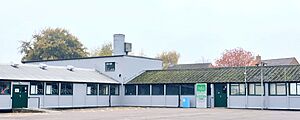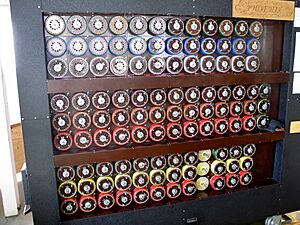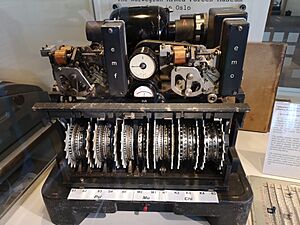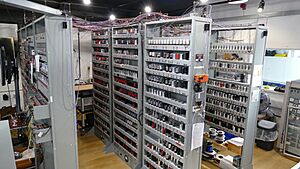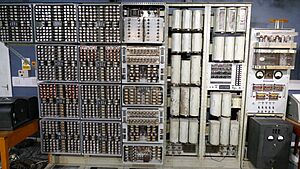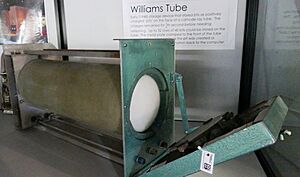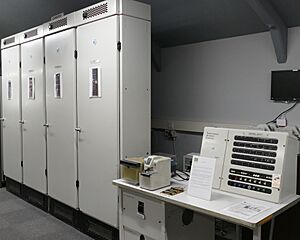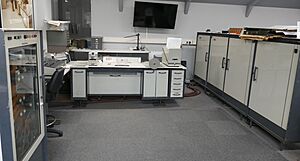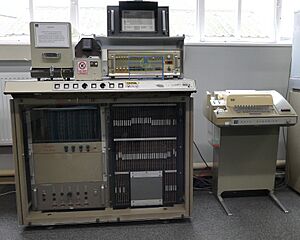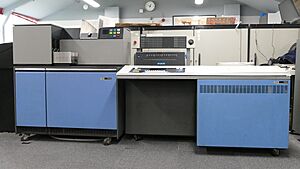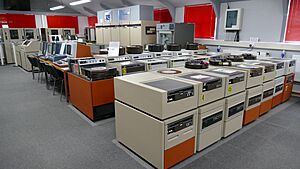The National Museum of Computing facts for kids
 |
|
| Established | 2007 |
|---|---|
| Location | Bletchley Park, UK SatNav MK3 6DS |
| Accreditation | Nationally-styled museum by Arts Council England |
| Public transit access | Bletchley Train Station |
The National Museum of Computing is a museum in the UK. It collects and fixes old computer systems. It has the world's biggest collection of working old computers. The museum is located at Bletchley Park in Milton Keynes, UK. It opened in 2007 in Block H. This was the world's first building made just for computers. Six of the ten Colossus computers from World War II were kept there.
The museum has early computers like the Harwell Dekatron computer. This is the world's oldest working digital computer. It also has Mainframe computers from the 1950s to 1970s. You can also see many personal computers and a classroom full of BBC Micros. The museum welcomes everyone, including schools and groups.
Even though it's at Bletchley Park, the museum is a separate charity. It has its own entry fee. It doesn't get money from the government. It relies on ticket sales and donations. The museum has a cafe and a gift shop. In 2024, it became a fully recognized national museum.
Contents
- How the Museum Started
- Amazing Computer Exhibits
- Bombe Gallery: Cracking Codes
- Tunny and Colossus Galleries: Secret Messages
- First Generation Gallery: Early Computers
- Large Systems Gallery: Mainframes and Minis
- PC Gallery: Home and Business Computers
- Simulation Gallery: Virtual Worlds
- Innovation Hub and BBC Classroom: Learning with Computers
- Internet Gallery: How the Internet Started
- Museum Funding
- Visiting the Museum
- See also
How the Museum Started
Bletchley Park was almost torn down in the late 1980s. It was saved in 1993 by the Bletchley Park Trust. Tony Sale was a key member of this group. He was a scientist who knew a lot about electronics and computers. Tony Sale helped restore old computers for the Science Museum, London. He became the first curator of the Bletchley Park Museum.
In 1993, Tony Sale and volunteers began rebuilding a Colossus computer in Block H. By 1996, a working prototype was ready. In 2004, Block H was again in danger of being demolished. Tony Sale helped protect it by getting it listed as a special building. This led to the computer collection becoming a separate museum. It officially became The National Museum of Computing in 2007.
A team led by John Harper built a working replica of a Turing-Welchman Bombe. This machine helped decode Enigma messages. It was moved to Block H in 2018.
Amazing Computer Exhibits
The museum shows only some of its collection. The exhibits tell the story of how computers grew in Britain. You can visit different galleries in order. They start with the World War II machines used by codebreakers.
Bombe Gallery: Cracking Codes
This gallery explains how the Enigma code was broken. Enigma machines were used by Germans to send secret messages. Alan Turing and Gordon Welchman improved an idea from Polish codebreakers. They created a machine to help decode Enigma messages. This gallery has a working replica of a Bombe machine. It also has a working replica Enigma machine and other related items.
A team led by John Harper built the replica Bombe. They used old documents and drawings from the war. Volunteers run and show the machine to visitors regularly.
Tunny and Colossus Galleries: Secret Messages
These galleries tell a different story. It's about breaking messages from the 12-rotor Lorenz SZ machine. This machine was even more secure than Enigma. The Tunny gallery shows one of the few Lorenz SZ42 machines left. The Allies didn't even see one until after World War II ended.
'Tunny' was the name for these messages and the secret machine. The gallery shows a copy of the original listening station. It has old radio receivers and paper tape equipment. You can also see a working replica of a British Tunny machine. This machine copied the Lorenz machine exactly. There's also a working replica of the Heath Robinson machine. This was an early version of the Colossus.
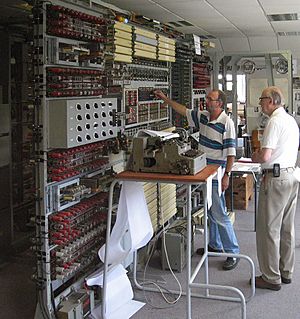
The Colossus gallery has a working rebuild of a Colossus Mark 2. Tony Sale realized how important these machines were. He and his team spent 14 years rebuilding this machine. It was finished in 2007.
Colossus is a very big machine, weighing five tonnes. It was built to help break 'Tunny' messages. It had 2,420 valves (vacuum tubes). It could be programmed to count specific patterns in messages. This machine is a recreation of the world’s first large-scale electronic programmable digital computer.
First Generation Gallery: Early Computers
This gallery shows early computers that used valves or tubes. It has three large, unique machines and other items.
- EDSAC – a replica that is almost finished. Volunteers are building and will run this machine. The original EDSAC was built at Cambridge University. It ran its first programs in 1949. It is considered the first practical general-purpose stored-program computer. EDSAC helped scientists win three Nobel Prizes.
- Harwell Dekatron (also called the WITCH) from 1951. This is the world’s oldest original working digital computer. It was designed to do boring calculations automatically. It started running in 1951. It once ran for ten days straight without stopping! It was used for computer education until 1973. Volunteers restored it at the museum in 2012.
- Hollerith Electronic Computer (HEC 1) from 1951. This machine is almost as old as the WITCH. It is not currently working. It was a prototype for commercial computers.
These early computers greatly influenced how computing grew in the UK. The WITCH is still a great tool for learning today.
Smaller items include:
- A Williams–Kilburn tube. This was the first random-access memory device. It led to the world's first stored program computer.
- Parts from the Manchester Mark 1 computer and an Atlas supercomputer. The Atlas was once the world's most powerful computer.
Large Systems Gallery: Mainframes and Minis
This gallery has many machines from the 1960s, 70s, and 80s. Many of them still work.
- Marconi TAC. This was one of the first transistor computers in the UK. The one on display was used at a nuclear power station. It ran non-stop from 1968 to 2004.
- Elliott 803. This was an early UK transistor machine from 1962. It was restored and now plays music and solves math problems.
- Elliott 903 from 1965. This desk-sized machine was popular in universities. It was used for teaching and science.
- IBM 1130 introduced in 1965. This is a rare IBM computer. Most were rented and then thrown away. This one was used at Liverpool University.
- ICL 2966 (1970s/1980s). This huge machine is a true mainframe. It takes up almost a third of the gallery space. Most large mainframes were scrapped. Tony Sale helped save this one. Volunteers are working to restore it. Visitors can play games like noughts and crosses on it.
- PDP-11 The PDP-11/73 (1995) was a support computer for a nuclear power station.
PC Gallery: Home and Business Computers
This gallery shows many home and business computers from the 1980s and 1990s. Visitors can play popular old computer games here. You can see:
- An early desktop PDP-8 from the 1960s.
- Early self-build machines from Nascom and Altair.
- Popular computers from IBM, Apple, Acorn, Commodore, Atari.
- A NeXTcube similar to the one Sir Tim Berners-Lee used to create the first web browser.
- A display showing how portable computers evolved. Early ones were called "Desktops with a Handle."
Simulation Gallery: Virtual Worlds
This gallery has systems that simulate reality. These include:
- A Cray-1 supercomputer. It was used to simulate weather and nuclear reactions.
- Games consoles where visitors can play early computer games like Space Invaders.
- Silicon Graphics workstations used to view 3-D models.
- Analogue computers that simulate real-world actions.
Innovation Hub and BBC Classroom: Learning with Computers
These are two connected education areas. The Innovation Hub has new technology from Fujitsu. The BBC Classroom has many working vintage BBC Micro computers. These machines were very popular in British schools in the 1980s. Over 1.5 million were sold. This classroom is used for workshops and talks for many groups.
Internet Gallery: How the Internet Started
This gallery tells the story of the internet. In 1965, Donald Davies had an idea for a network of computers. He thought data should be broken into small "packets." These packets would be switched quickly between computers. This idea of packet switching was adopted by ARPA in the US. It became the basis for ARPANET, which was the start of the Internet. The NPL's network was working even before ARPANET's first link in 1969.
Museum Funding
The museum relies on donations and admission fees. Many companies and organizations have donated. In 2018, the museum raised over £43,000 through crowdfunding. This was to build a new gallery for the Bombe.
The museum also received £500,000 for roof repairs and museum space updates. They needed to raise another £150,000 to get this money. In January 2023, they launched an appeal and successfully raised enough funds. Work on the roof started in early 2024.
Visiting the Museum
The museum is usually open four days a week: Tuesdays, Thursdays, Saturdays, and Sundays. It opens from 10:30 am to 4:30 pm in winter, and until 5 pm in summer. Demonstrations in the Bombe, Tunny, and Colossus galleries happen every hour. Guided tours are available at 2 pm on Tuesdays, Thursdays, and Sundays. It's a good idea to book tours because places are limited.
You can find admission prices on the museum website. There are discounts for students and children. Annual tickets are also available for unlimited visits.
See also


